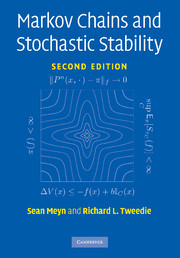Book contents
- Frontmatter
- Contents
- List of figures
- Prologue to the second edition
- Preface to the second edition
- Preface to the first edition
- I COMMUNICATION and REGENERATION
- II STABILITY STRUCTURES
- III CONVERGENCE
- 13 Ergodicity
- 14 f-Ergodicity and f-regularity
- 15 Geometric ergodicity
- 16 V-Uniform ergodicity
- 17 Sample paths and limit theorems
- 18 Positivity
- 19 Generalized classification criteria
- 20 Epilogue to the second edition
- IV APPENDICES
- Bibliography
- General index
- Symbols
13 - Ergodicity
Published online by Cambridge University Press: 05 August 2012
- Frontmatter
- Contents
- List of figures
- Prologue to the second edition
- Preface to the second edition
- Preface to the first edition
- I COMMUNICATION and REGENERATION
- II STABILITY STRUCTURES
- III CONVERGENCE
- 13 Ergodicity
- 14 f-Ergodicity and f-regularity
- 15 Geometric ergodicity
- 16 V-Uniform ergodicity
- 17 Sample paths and limit theorems
- 18 Positivity
- 19 Generalized classification criteria
- 20 Epilogue to the second edition
- IV APPENDICES
- Bibliography
- General index
- Symbols
Summary
In Part II we developed the ideas of stability largely in terms of recurrence structures. Our concern was with the way in which the chain returned to the “center” of the space, how sure we could be that this would happen, and whether it might happen in a finite mean time.
Part III is devoted to the perhaps even more important, and certainly deeper, concepts of the chain “settling down”, or converging, to a stable or stationary regime.
In our heuristic introduction to the various possible ideas of stability in Section 1.3, such convergence was presented as a fundamental idea, related in the dynamical systems and deterministic contexts to asymptotic stability. We noted briefly, in (10.4) in Chapter 10, that the existence of a finite invariant measure was a necessary condition for such a stationary regime to exist as a limit. In Chapter 12 we explored in much greater detail the way in which convergence of Pn to a limit, on topological spaces, leads to the existence of invariant measures.
In this chapter we begin a systematic approach to this question from the other side. Given the existence of π, when do the n-step transition probabilities converge in a suitable way to π?
We will prove that for positive recurrent ψ-irreducible chains, such limiting behavior takes place with no topological assumptions, and moreover the limits are achieved in a much stronger way than under the tightness assumptions in the topological context. The Aperiodic Ergodic Theorem, which unifies the various definitions of positivity, summarizes this asymptotic theory.
- Type
- Chapter
- Information
- Markov Chains and Stochastic Stability , pp. 313 - 335Publisher: Cambridge University PressPrint publication year: 2009

